How to activate XStore SEO settings #
XStore has Built-in SEO functionality. With these Built-in SEO options, your website will be more visible, effective, and successful than ever before. Improve your website’s search engine rankings with our powerful Built-in SEO options. To use XStore’s SEO feature, please navigate to XStore > Theme Options > SEO > Enable SEO Settings and Publish it.
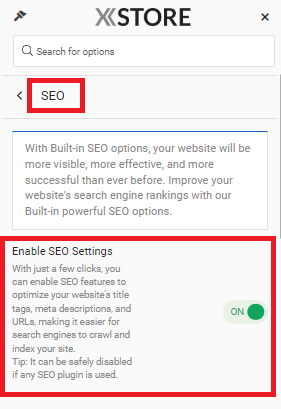
With just a few clicks, you can enable SEO features to optimize your website’s title tags, meta descriptions, and URLs, making it easier for search engines to crawl and index your site.
If you are using any SEO plugin, this can be safely disabled.
Custom Meta Description: #
The meta description is a summary of the content of a page which is displayed to users in the search results. It is one of the first things people will see when searching for something, so it is important to optimize it for SEO. This is your opportunity to convince users to click on your result! Leave it empty to use the site tagline set in the General settings.
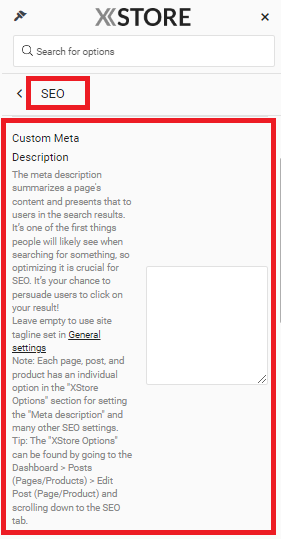
Note: Each page, post, and product has an individual option in the “XStore Options” section for setting the “Meta description” and many other SEO settings.
Each page, post, and product has an individual option in the “XStore Options” section for setting the “Meta description” and many other SEO settings.
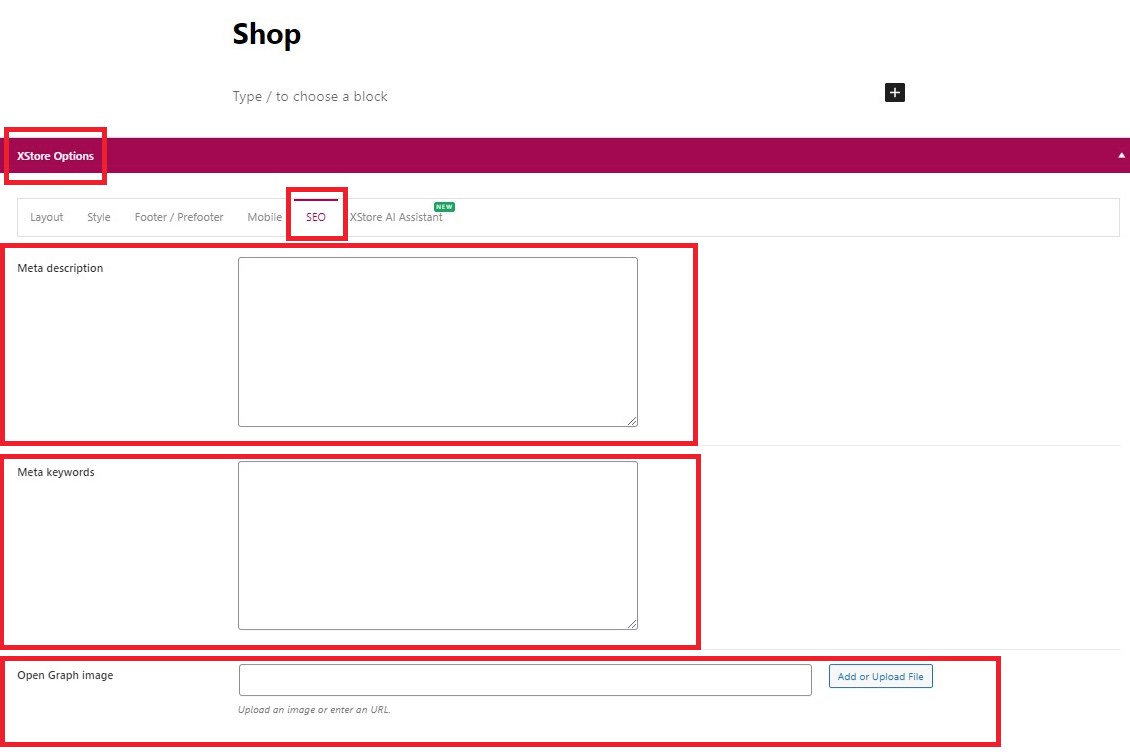
Meta Keywords: #
Meta keywords refer to a specific feature in search engine optimization (SEO) where you can add relevant keywords to your online content. These keywords are intended to improve the visibility and ranking of your content in search engine results pages (SERPs). By strategically selecting and incorporating relevant keywords into your content, you can increase the chances of your webpages appearing higher in search engine rankings.
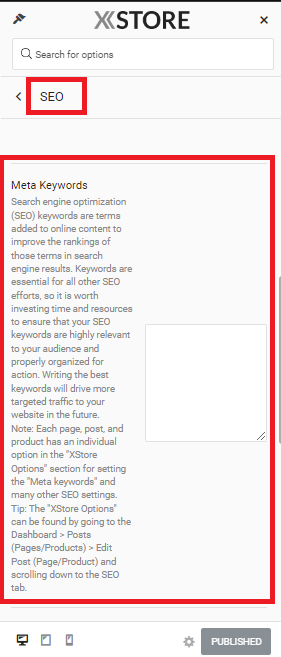
Note: Each page, post, and product has an individual option in the “XStore Options” section for setting the “Meta keywords” and many other SEO settings.
The “XStore Options” can be found by going to the Dashboard > Posts (Pages/Products) > Edit Post (Page/Product) and scrolling down to the SEO tab.
To use meta keywords effectively, follow these steps:
- 1
- Identify relevant keywords: Conduct keyword research to find terms that are commonly searched by your target audience and are relevant to your content. Tools like Google Keyword Planner can assist you in finding suitable keywords.
- 2
- Organize your keywords: Categorize your keywords based on the different topics or themes of your content. This helps in organizing your SEO efforts and makes it easier to optimize individual pages or posts.
- 3
- Implement meta keywords: In the “XStore Options” section of your website, you can find the option to set the “Meta keywords” for each page, post, or product. Access this section by going to the Dashboard, then selecting Posts (Pages/Products), and finally, Edit Post (Page/Product). Scroll down to the SEO tab to find the relevant field for meta keywords.
- 4
- Add relevant keywords: In the meta keywords field, enter the keywords that are relevant to the specific page, post, or product you are optimizing. Ensure that these keywords accurately reflect the content and align with the interests of your target audience.
- 5
- Avoid keyword stuffing: While it’s important to include relevant keywords, avoid overusing them excessively. Keyword stuffing can harm your SEO efforts and may lead search engines to penalize your website. Focus on providing valuable content and using keywords naturally within the text.
Open Graph Image: #
The Open Graph Image refers to an image that is specifically designated to be displayed when a URL is shared on social media platforms like Facebook, Twitter, or LinkedIn. Open Graph meta tags are snippets of HTML code that control how the URL appears when shared on these platforms. When you share a URL on social media, the platform automatically fetches the relevant information from the webpage, such as the title, description, and image. By using Open Graph meta tags, you can have more control over how your URL is represented on social media.
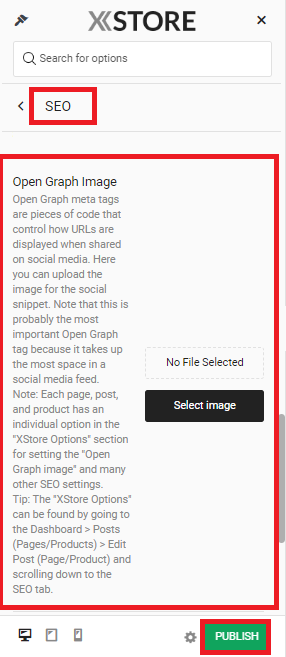
Note: Each page, post, and product has an individual option in the “XStore Options” section for setting the “Open Graph image” and many other SEO settings.
The “XStore Options” can be found by going to the Dashboard > Posts (Pages/Products) > Edit Post (Page/Product) and scrolling down to the SEO tab.
To use the Open Graph Image effectively, you need to follow these steps:
- 1
- Choose a suitable image: Select an image that is visually appealing, relevant to the content being shared, and preferably in a square or landscape format. The recommended image size may vary depending on the social media platform, but a common aspect ratio is 1.91:1.
- 2
- Upload the image: Access the “XStore Options” section, which is typically found in the dashboard of your website. Locate the specific page, post, or product for which you want to set the Open Graph image. In the “XStore Options” section, you will find an option to upload the image.
- 3
- Set the Open Graph image: Edit the desired page, post, or product and scroll down to the SEO tab within the editing interface. Look for the option labeled “Open Graph image”. Add or Upload the previously chosen image to this field.
- 4
- Save and publish: Once you have uploaded the Open Graph image, save the changes and publish the page, post, or product. The designated image will now be associated with the URL and will be displayed when shared on social media.
“Noindex” Tag for Url: #
The “noindex” tag is an HTML meta tag that can be used to instruct search engines not to index a specific web page. When the “noindex” tag is added to a page’s meta tags, search engines will exclude that page from their index, meaning it won’t appear in search engine results.to enable the “noindex” tag for the shop page URL when the URL has additional parameters, such as “?min_price=120,” “?page=2,” or “?filter_pa_color=blue.” By enabling this option, you are telling search engines not to index the shop page when it has those additional parameters in the URL.

By doing this, search engines will not include the shop page in their search results when those specific additional parameters are present in the URL. This can be useful if you want to prevent duplicate or irrelevant content from appearing in search engine results, especially when certain parameters are used for filtering or sorting purposes on the shop page.
The Xstore theme includes a built-in Search Engine Optimization (SEO) feature that can help optimize your website for better visibility in search engine results. These options are designed to improve your website’s search engine rankings and increase organic traffic. However, if you require additional SEO features or more advanced customization options than what the Xstore theme provides, you have the option to use the Yoast SEO plugin.


